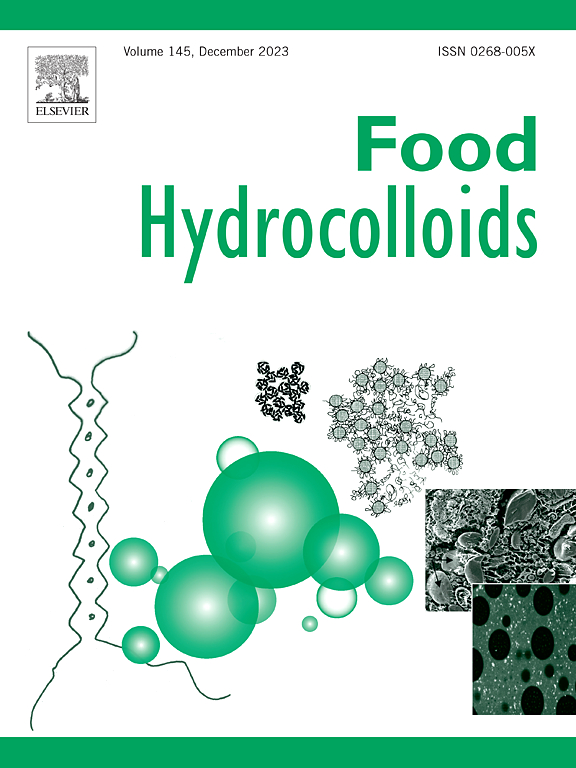姜黄衍生物姜黄素在环糊精金属-有机骨架中的多位点相互作用增强了苹果汁的吸附和溶解度
IF 11
1区 农林科学
Q1 CHEMISTRY, APPLIED
引用次数: 0
摘要
γ-环糊精金属-有机骨架(CD-MOF)作为功能剂或药物的载体具有很高的潜力,但其作为承载材料的结构优势相对于γ-CD的研究尚不清楚。本文以姜黄素(curcumin, CUR)为代表的生物活性化合物,探讨了CD和CD- mof的结构差异对CUR吸附性能的影响,以及CUR在γ-CD和CD- mof中的包封机制。CD- mof吸附CUR需要较高的能量消耗(在加热条件下),而CD- mof在温和条件下可以很容易地吸附CUR,最大吸附量为149.98 mg g−1,比CD (80.18 mg g−1)增强1.87倍。DFT理论计算和光谱学分析表明,CD-MOF对CUR的吸附优于γ-CD,主要是由于CD-MOF中存在氢键、静电吸引、vdW相互作用等多位点主客体相互作用。此外,由于CD-MOF与CUR之间的多位点相互作用,与游离CUR (11 ng/mL)和γ-CD中的CUR相比,CD-MOF中CUR的水溶性(0.25 mg/mL)显著提高,同时CD-MOF的孔屏蔽作用有效地掩盖了其苦味。从褐变指数、亮度、溶解度、苦味等方面综合评价了CD-MOF包封的CUR作为食品添加剂在苹果汁中的应用潜力。这项工作为CD-MOF作为功能食品开发中生物活性化合物的首选载体的结构优势提供了关键的见解。本文章由计算机程序翻译,如有差异,请以英文原文为准。

Multi-sites interactions of turmeric-derived curcumin in cyclodextrin metal-organic framework for the enhanced adsorption and solubility in apple juice
γ-Cyclodextrin metal-organic framework (CD-MOF) have high potential as a carrier for functional agent or drug delivery, but the structure advantages of CD-MOF as superior hosting materials over γ-CD are poorly understand. In this work, curcumin (CUR) as the representative bioactive compound, the structure difference of CD and CD-MOF on the adsorption properties of CUR and the underlying encapsulation mechanism of CUR in γ-CD and CD-MOF were explored. Unlike the adsorption of CD for CUR requires the high energy cost (under heating), CD-MOF could readily adsorb CUR in the mild condition with the maximal adsorption amount of 149.98 mg g−1, showing the 1.87-fold enhancement over CD (80.18 mg g−1). The preferred CUR adsorption on CD-MOF over γ-CD was attributed to the multi-sites host-guest interactions including hydrogen bonding, electrostatic attraction, coupling with vdW interactions revealed by DFT theoretical calculations and spectroscopy analysis. Furthermore, attributed to multi-sites interactions between CD-MOF and CUR, the aqueous solubility (0.25 mg/mL) of CUR in CD-MOF was significantly improved compared to free CUR (11 ng/mL) and CUR in γ-CD, and meanwhile the unpleasant bitter taste was effectively covered by the pore shielding effect of CD-MOF. The higher potential of CUR encapsulated in CD-MOF over γ-CD using as food additive in apple juice was comprehensively evaluated by the browning index, lightness, solubility and bitterness. This work provides the key insight on the structure benefits of CD-MOFs as the preferred carries of CD-MOF for bioactive compounds in the development of functional food product.
求助全文
通过发布文献求助,成功后即可免费获取论文全文。
去求助
来源期刊

Food Hydrocolloids
工程技术-食品科技
CiteScore
19.90
自引率
14.00%
发文量
871
审稿时长
37 days
期刊介绍:
Food Hydrocolloids publishes original and innovative research focused on the characterization, functional properties, and applications of hydrocolloid materials used in food products. These hydrocolloids, defined as polysaccharides and proteins of commercial importance, are added to control aspects such as texture, stability, rheology, and sensory properties. The research's primary emphasis should be on the hydrocolloids themselves, with thorough descriptions of their source, nature, and physicochemical characteristics. Manuscripts are expected to clearly outline specific aims and objectives, include a fundamental discussion of research findings at the molecular level, and address the significance of the results. Studies on hydrocolloids in complex formulations should concentrate on their overall properties and mechanisms of action, while simple formulation development studies may not be considered for publication.
The main areas of interest are:
-Chemical and physicochemical characterisation
Thermal properties including glass transitions and conformational changes-
Rheological properties including viscosity, viscoelastic properties and gelation behaviour-
The influence on organoleptic properties-
Interfacial properties including stabilisation of dispersions, emulsions and foams-
Film forming properties with application to edible films and active packaging-
Encapsulation and controlled release of active compounds-
The influence on health including their role as dietary fibre-
Manipulation of hydrocolloid structure and functionality through chemical, biochemical and physical processes-
New hydrocolloids and hydrocolloid sources of commercial potential.
The Journal also publishes Review articles that provide an overview of the latest developments in topics of specific interest to researchers in this field of activity.
 求助内容:
求助内容: 应助结果提醒方式:
应助结果提醒方式:


